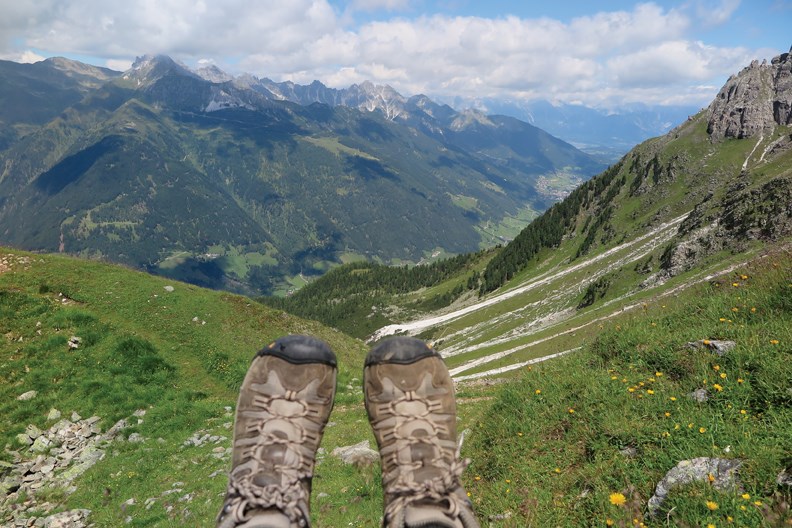I have always loved mountains. They make me feel closer to heaven, which is how I felt hiking the Alps in Austria this summer.
The adventure began with the view from my balcony at the Hotel Sonnhof in Neustift, a village in central Tyrol surrounded by the nearly 500 mountains of the Stubai Alps. I was awed by the nearby mountains with cable cars ascending and descending, the wood-shingled church clock tower with its bells, the red tile roofs and white stucco of the village houses with their carved wooden balconies and window boxes overflowing with red geraniums, the village fields being mowed for hay, and the Stubai valley stretching out before me. Only a short distance from Innsbruck, Neustift is easily reached by a local bus that travels regularly up and down the 30-kilometre Stubai valley, which serves as an excellent base for a week’s Alpine hiking.
Neustift is known as the “Alpine Guide Village” after Pastor Franz Senn (1831-1884), the Austrian priest and mountaineer, known as the “glacier pastor,” who co-founded the Austrian and German alpine associations to encourage tourism and thus help alleviate the poverty of his parishioners. Pastor Senn’s memorial can be visited at the cemetery of St. George Church. The church was originally founded by Austrian Emperor Maximilian I in 1515, so that his area hunting parties would not be disrupted by a lengthy Sunday trek to a further-off church. St. George is now famous for its baroque frescoes that create the optical illusion of deeply-domed ceilings, and elaborate rococo altar and pillars made of wood, so carefully decorated you would swear they were carved marble.
I also took in a photographic exhibit, Living at the Edge, at the town hall and became even more convinced of the authenticity of the mountain experience in Neustift while viewing geographer and ethnologist Erika Hubatschek’s photographs of the town’s inhabitants from 80 years ago, many of which were matched to people still living and houses that remain to the present day.
My first trip up the mountain was on the Elfer cable car, reached by a short walk through town. With my hiking group, I ascended to the Elferhütte, one of the many huts, which are actually restaurants with long traditions, many with rooms for overnighting, that dot the Alps. From there I followed a balcony path through flower meadows and paused to smell a scented orchid and watch a blue gentian unfurl in the sun. There is a German saying that people who love the mountains reflect sunlight, while those who remain in the valley do not understand this language. So true, I felt as, after hiking up a steep col, I was rewarded with the experience of spreading out on the grassy ledge with my sandwiches for lunch and the mountain peaks just beyond my boots.
The next day we took the local bus to a different cable car, this time to view one of the many glaciers of the upper Stubai. After descending to the Dresdner Hütte, we hiked to an alpine lake and on to a high pass and through more meadows. Not only did I hear the whistling of the Alpenmurmeltier (alpine marmot), but I was lucky enough to spot one darting between the rocks.
On Day three, we took a bus north to catch the Serles Gondola, from which we walked a pilgrimage path founded in 1429, to the Maria Waldrast Monastery, originally a place of rest for herders, which included an image of Mary grown into a tree trunk that was found by two shepherd boys and a healing spring from the 16th century. For my group, I translated into English all the 15 German religious markers along the path. We hiked a nature and inspirational path, Schöpfungsweg, with signs and stops designed to explain nature or encourage creative reflection, stopping at two different huts for refreshment, but then racing down the last section to the cable car station as we heard thunder approaching. Alas, the cable car was closed down for about an hour until the lightning storm passed.
The next to last day was our only rainy day, which fittingly was our day for hiking the WildeWasserWeg – the Wild Water Trail – to the Sulzenau and Grawa Waterfalls. For our final day in the Stubai, we took the Schlick 2000 cable car to climb to the Sennjochhütte, where I spotted more alpine roses, gentia and herb-paris on the way. I decided to do the Scheibenweg. Each participant takes a large wooden disk and after placing it in a knee-high wooden groove parallel to the trail, races it down the trail, catches it, and places it in the next downhill section, until, in no time, the descent of the day is accomplished – a great game for those who dread facing the last leg of any hike.
My flights were booked through a Sunshine Coast travel agency, and the guided hiking and accommodation were arranged by HF Holidays, a cooperative. A Stubai card can be purchased easily and lets you ride all buses and cable cars without further charge, as Austria supports getting people out of cars and into public transport.



